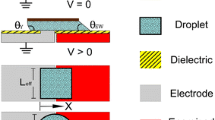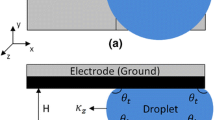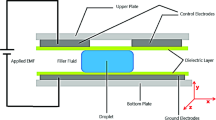Abstract
A hydrodynamic scaling model of droplet actuation in an electrowetting-on-dielectric (EWD) actuator is presented that takes into account the effects of contact angle hysteresis, drag from the filler fluid, drag from the solid walls, and change in the actuation force while a droplet traverses a neighboring electrode. Based on this model, the threshold voltage, V T, for droplet actuation is estimated as a function of the filler medium of a scaled device. It is shown that scaling models of droplet splitting and liquid dispensing all show a similar scaling dependence on [t/εr(d/L)]1/2, where t is insulator thickness and d/L is the aspect ratio of the device. It is also determined that reliable operation of a EWD actuator is possible as long as the device is operated within the limits of the Lippmann–Young equation. The upper limit on applied voltage, V sat, corresponds to contact-angle saturation. The minimum 3-electrode splitting voltages as a function of aspect ratio d/L < 1 for an oil medium are less than V sat. However, for an air medium the minimum voltage for 3-electrode droplet splitting exceeds V sat for d/L ≥ 0.4. EWD actuators were fabricated to operate with droplets down to 35pl. Reasonable scaling results were achieved.















Similar content being viewed by others
Notes
Teflon AF Product Information Bulletin, DuPont, Wilmington, DE, USA.
Technical Bulletin, Bellex International Corp., Wilmington, DE, USA.
References
Baird ES, Mohseni K (2007) A unified velocity model for digital microfluidics. Nanoscale Microscale Thermophys Eng 11:109–120
Baviere R, Boutet J, Fouillet Y (2008) Dynamics of droplet transport induced by electrowetting actuation. Microfluidics Nanofluidics 4:287–294
Beard KV, Pruppacher HR (1969) A determination of the terminal velocity and drag of small water drops by means of a wind tunnel. J Atmos Sci 26:1066–1072
Berge B (1993) Electrocapillarite et mouillage de films isolants par l’eau. C R Acad Sci II 317:157
Berry S, Kedzierski J, Abedian B (2006) Low voltage electrowetting using thin fluoropolymer films. J Colloid Interface Sci 303:517–524
Berry S, Kedzierski J, Abedian B (2007) Irreversible electrowetting on thin fluoropolymer films. Langmuir 23:12429–12435
Berthier J, Clementz PH, Raccurt O, Jary D, Claustre P, Peponnet C, Fouillet Y (2006) Computer aided design of an EWOD microdevice. Sens Actuators A 127:283–294
Berthier J, Dubois P, Clementz P, Claustre P, Peponnet P, Fouillet Y (2007) Actuation potentials and capillary forces in electrowetting based microsystems. Sens Actuators A 134:471–479
Brochard F (1989) Motions of droplets on solid surfaces induced by chemical or thermal gradients. Langmuir 5:432–438
Cho S-K, Moon H, Fowler J, Kim C-J (2001) Splitting a liquid droplet for electrowetting-based microfluidics. In: Proceedings of 2001 ASME Inter Mech Eng Congress and Expo, November 11–16, New York, NY, USA
Cho S-K, Fan S-K, Moon H, Kim C-J (2002) Towards digital microfluidic circuits: creating, transporting, cutting and merging liquid droplets by electrowetting-based actuation. In: TechDig MEMS 2002 IEEE Inter Conf on Micro Electro Mechanical Systems, vol 11, pp 454–61
Cooney CG, Chen C-Y, Emerling MR, Nadim A, Sterling JD (2006) Electrowetting droplet microfluidics on a single planar surface. Microfluid Nanofluid 2:435–446
Dennard RH, Gaensslen FH, Yu H-N, Rideout VL, Bassous E, LeBlanc AR (1974) Design of ion-implanted MOSFETs with very small physical dimensions. IEEE J Solid State Cir SC-9:256–268
Fair RB, Pollack MG, Woo R, Pamula VK, Ren H, Zhang T, Venkatraman J (2001) A microwatt metal-insulator-solution-transport (MIST) device for scalable digital bio-microfluidic systems. Technical Digest, Inter. Electron Device Meeting, pp 367–370
Fair RB, Srinivasan V, Paik P, Ren H, Pamula VK, Pollack MG (2003) Electrowetting-based on-chip sample processing for integrated microfluidics. Tech Dig IEEE Inter Electron Dev Meeting, pp 779–782
Fair RB (2007) Digital microfluidics: is a true lab-on-a-chip possible? Microfluid Nanofluid 3:245–281
Fair RB, Song JH, Evans RD, Lin Y-T, Hsu B–N (2008) Scaling EWD actuators for picoliter applications. In: 6th Inter. Meeting on Electrowetting, Los Angeles, August 21, 2008
Kedzierski J, Berry S (2006) Engineering the electrocapillary behavior of electrolyte droplets on thin fluoropolymer films. Langmuir 22:5690–5696
Link DR, Anna SL, Weitz A, Stone HA (2004) Geometrically meditated breakup of drops in microfluidic devices. Phys Rev Lett 92:05403–05404
Mastrangelo CH, Burns MA, Burke DT (1998) Microfabricated devices for genetic diagnostics. Proc IEEE 86:1769–1787
Moon H, Cho SK, Garrell RL, Kim CJ (2002) Low voltage electrowetting-on-dielectric. J Appl Phys 92:4080–4087
Moon H, Wheeler AR, Garrell RL, Loo JA, Kim C-J (2006) An integrated digital microfluidic chip for multiplexed proteomic sample preparation and analysis by MADDA-MS. Lab Chip 6:1213–1219
Mugele F, Baret JC (2005) Electrowetting: from basics to applications. J Phys Condens Matter 17:R705–R774
Mugele F, Baret J-C, Steinhauser D (2006) Microfluidic mixing through electrowetting-induced droplet oscillations. Appl Phys Lett 88:204106
Paik P (2003) Rapid droplet mixers for digital microfluidic systems. MS Thesis, Duke University
Paik P, Pamula VK, Pollack MG, Fair RB (2003a) Electrowetting-based droplet mixers for microfluidic systems. Lab Chip 3:28–33
Paik P, Pamula VK, Fair RB (2003b) Rapid droplet mixers for digital microfluidic systems. Lab Chip 3:253–259
Papathanasiou AG, Papaioannou AT, Boudouvis AG (2008) Illuminating the connection between contact angle saturation and dielectric breakdown in electrowetting through leakage current measurements. J Appl Phys 103:034901
Park J (2007) A liquid lens based on electrowetting. MS Thesis, LSU
Pollack MG (2001) Electrowetting-based microactuation of droplets for digital microfluidics. PhD thesis, Duke University
Pollack MG, Fair RB, Shenderov AD (2000) Electrowetting-based actuation of liquid droplets for microfluidic applications. Appl Phys Lett 77:1725–1727
Quinn A, Sedev R, Ralston J (2005) Contact angle saturation by electrowetting. J Phys Chem 109:6268–6275
Reddy SB, Mathur KV (1988) Measurement of interfacial tension of immiscible liquids of equal density. AlChE J 34:155–157
Ren H (2004) Electrowetting-based sample preparation: an initial study for droplet transportation, creation and on-chip digital dilution. PhD Thesis, Duke University
Ren H, Fair RB, Pollack MG, Shaughnessy EJ (2002) Dynamics of electrowetting droplet transport. Sens Act B 87:201–206
Ren H, Srinivasan V, Fair RB (2003a) Design and testing of an interpolating mixing architecture for electrowetting-based droplet on-chip chemical dilution. In: 12th Inter conf on solid-state sensors, actuators and microsystems. Digest of technical papers, pp 619–622
Ren H, Srinivasan V, Fair RB (2003b) Automated electrowetting-based droplet dispensing with good reproducibility. Proc MicroTAS 2003:993–996
Song H, Bringer MR, Tice JD, Gerdts CJ (2003) Experimental test of scaling of mixing by chaotic advection in droplets moving through microfludic channels. Appl Phys Lett 83:4664–4666
Srinivasan V (2005) A digital microfluidic lab-on-a-chip for clinical applications. PhD Thesis, Duke University
Srinivasan V, Pamula V, Rao KD, Pollack MG, Izatt JA, and Fair RB (2003) 3-D imaging of moving droplets using optical coherence tomography. In: Seventh international conference on miniaturized chemical and biochemical analysis systems (μTAS 2003), Lake Tahao
Vallet M, Vallade M, Berge B (1999) Limiting phenomena for the spreading of water on polymer films by electrowetting. Eur Phys J B 11:583–591
Verheijen HJ, Prins MWJ (1999) Reversible electrowetting and trapping of charge: model and experiments. Langmuir 15:6616–6620
Welters WJ, Fokkink GJ (1998) Fast electrically switchable capillary effects. Langmuir 14:1535–1538
Wheeler AR, Moon H, Kim C-J, Loo JA, Garrell RL (2004) Electrowetting-based microfluidics for analysis of peptides and proteins by matrix-assisted laser desorption/ionization mass spectrometry. Anal Chem 76:4833–4838
Yue R-F, Wu J-G, Zeng XF, Kang M, Liu LT (2006) Demonstration of four fundamental operations of liquid droplets for digital microfluidic systems based on an electrowetting-on-dielectric actuator. Chin Phys Lett 23:2303–2306
Zeng J, Korsmeyer T (2004) Principles of droplet electrohydrodynamics for lab-on-a-chip. Lab Chip 4:265–277
Acknowledgments
This research was supported by Ministry of Education, Science and Technology of Korea and a CMMI grant from the National Science Foundation.
Author information
Authors and Affiliations
Corresponding author
Rights and permissions
About this article
Cite this article
Song, J.H., Evans, R., Lin, YY. et al. A scaling model for electrowetting-on-dielectric microfluidic actuators. Microfluid Nanofluid 7, 75–89 (2009). https://doi.org/10.1007/s10404-008-0360-y
Received:
Accepted:
Published:
Issue Date:
DOI: https://doi.org/10.1007/s10404-008-0360-y




